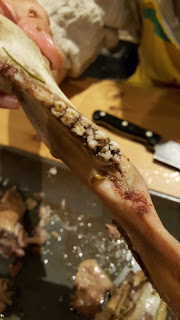Geese. Water buffalo. Fishing lake. Dexter cattle. Houseboat. Grazing.
In no particular order, all of the above have, at one time or other over the last six years, been suggested as potential "uses" of our acres of wet grassland.
Buffalo and cattle need fencing. Geese need a house
and fencing. A lake needs digging and dredging. A houseboat needs a lake, which needs digging and dredging. Grazing needs drainage, which is just digging and dredging in lines rather than one big hole. Ultimately every one of them has the potential to damage the existing eco-system of the grassland. Scrap that, every one of them WILL damage the existing eco-system of the grassland. A damaged eco-system is not good for wildlife, specifically not good for the wildlife that barn owls like to hunt and eat. So ultimately every one of them has the potential to drive away our resident barn owls. And we wouldn't want that!
The upshot of six years of deliberation, procrastination and letting the grassland do its own thing, is that we have decided to let the grassland do its own thing. The difference is that from now on it is going to be a managed do its own thing. To date, doing its own thing appears to have consisted largely of growing willow. So in my untrained and uninformed mind a managed do its own thing would essentially entail managing willow. As luck would have it, Denmark Farm, the conservation centre down the road near Lampeter, had a free willow management course coming up, so I signed David up and sent him off with pen, paper and a packed lunch.
He came back with pretty pictures of pretty things made from willow (leaving me with the need to have a giant woven willow ball in my life). He also came back knowing how to coppice willow. Most important of all, he came back knowing that the willow he had just learned to coppice is completely different to the type of willow growing in our grassland. When is a willow not a willow? When it's the other willow. All was not lost however, for on the course was a man who knew about both willows and, to David's great excitement (we don't get out much these days), this man not only knew what willow we would need for burning in our biomass boiler, he also knew how we could grow it in our grassland. All of which explains why a few weeks later a corner of our grassland looked like this...

Okay, so I realise that black mulch sheeting is no better for the eco-system than a herd of water buffalo, BUT it's only temporary. It also looks a lot bigger in the picture than it is in real life (said the actress to the bishop). When David announced we would be planting 200 willow trees I tried to sound more positive than I felt. The memory of the after effects of using a mattock to dig one hole for one tree lingers still, and it isn't a happy one. Fortunately, when you're talking willow whips, there's a much simpler method. Push them in! BUT in the early weeks and months, the whips don't like competition from weeds and their ilk. Hence the sheet mulch.
David ordered the sheeting before he ordered the willow whips. No surprise then that the sheeting arrived before the willow whips. It was also no surprise that once the sheeting arrived, David just HAD to get it laid down IMMEDIATELY. No waiting for help. No checking the forecast, No checking willow whip estimated delivery date. You have to admire the enthusiasm that led him singly handedly to strim a 400 square metre area of the grassland and then roll out, lay and peg down sheeting of the same dimensions. Such a shame then that the following few days were so very, very windy. Windy enough, in fact, for the sheeting not only to rip out most of those pegs but to then toss aside the breeze blocks and tree trunks hastily put in their place. I envisaged this going one of two ways - either we would wake in total darkness with the front of the house shrouded in black mulch sheeting or the last we would see of it would be a swirling black cloud disappearing over the top of the valley like the giant cloak of a departing, cackling witch. Fortunately, David's diligence shuttling to and fro with wheelbarrow loads of rocks kept it grounded, if a little billowy round the edges. The willow whips which would anchor it properly were delivered a few days later and we were able to plant them straight-away. Well, I say straight-away, but actually there was a short pause between arrival and planting, allowing David to pose as a prone contemplative wizard....

Once that was out of his system and I had stopped giggling, we lugged the bundles of whips down to the grassland (a simple enough sounding task, but fraught with difficulty when I get the heavy end and get the giggles again while traversing tricky terrain). Safely at the location we revealed the whips...
.... and shoved them through slits in the sheeting....
.... all 200 of them ...
.... and then found the planting instructions at the bottom of the packaging. Hey ho, they're not dead yet though, so fingers crossed (and assuming that the willow man knew what he was talking about and wasn't just spinning a yarn, or perhaps weaving a willowy tale) in four year's time we'll be coppicing a year's worth of fuel.

















































